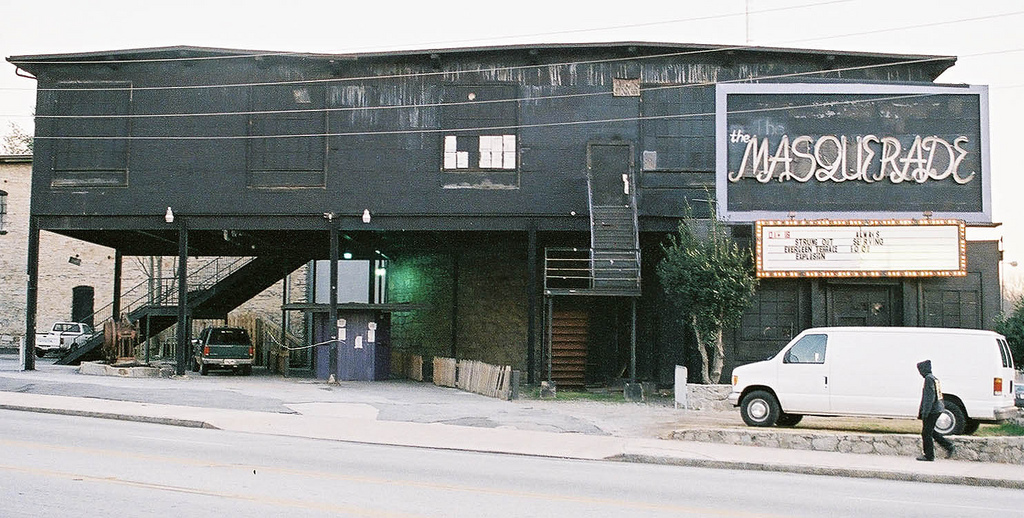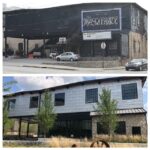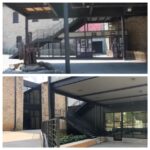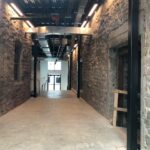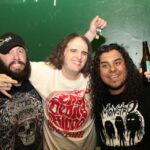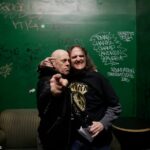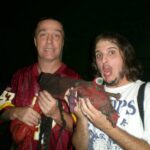In the beginning, 695 North Avenue was the Excelsior Mill, a family pizzeria/movie house. Eventually, things would change. The Masquerade debuted as a concert venue in 1990. The Masquerade would become not just an Atlanta institution, but a legendary concert venue known worldwide. 695 North Avenue (where The Masquerade was located) was in, what was then (at least to me, a kid from Jonesboro, GA) one of the seediest parts of town. It was located across the street from the backside of a Kroger shopping center that became lovingly known as Atlanta’s Murder Kroger. Although this part of Atlanta is now super trendy with Beltline coffee shops, expensive clothing stores, and overpriced bars, North Ave was primarily industrial. The Masquerade had a way of blending in with the non-descript warehouses and gravel parking lots surrounded by rusty chain link fences and standing out.
It was tall and imposing, looking a bit like a haunted mill (I wonder why Netherworld never tried to rent it out??), but it also looked like it could crumble at any moment. Its black steel siding, rickety roof, all sitting upon a stone and mortar foundation, hinted at the vibe that one would get inside the venue as well. It was an awe-inspiring thing to look at, and as a wee high school lad attending his first club show, I had never seen anything like it and never would again.

The first show I ever saw at the Masquerade was in 1991. I’m not sure of the exact date because I lost the stub ages ago, but it was GWAR. It was my first club show, and I was a bit nervous. My friend’s dad dropped us off at the door. He gave us a handful of quarters to use the payphone to call him when the show was over. (For my younger readers, let Uncle Don tell you about how back in the day, we didn’t have phones in our pockets and had to use, gasp, payphones). I won’t lie, I was nervous about what a club show crowd would be like, but more than anything, a sense of excitement filled me. This was a club! I’m going to a club to see a concert! Needless to say, I was ecstatic.
I will never forget the moment I walked into The Masquerade for the very first time. The cloud of cigarette smoke was so thick that I could barely see. The stench of spilled beer, body odor, and smoke was enough to knock you off your feet. The crowd was packed with tall, long-haired burnouts in denim jackets covered in patches, overweight high school kids with bad skin (much like myself), and women wearing less clothing than I had seen outside of the pages of an adult magazine. My head pounded from the volume of the music blasting over the PA. And you know what? It was fucking awesome. This place looked, sounded, and smelled like Rock N’ Roll.
One of the things that made The Masquerade so unique was that there were three different rooms in one building. After walking through the giant wooden castle-esque double doors, you found yourself in a small “lobby” area. If you looked straight ahead, you saw a rickety, precarious-looking staircase that led to the giant room upstairs, Heaven (this is where GWAR performed that night). To the right was Hell, and to the left, you guessed it, Purgatory. Years later, that staircase would collapse during a New Year’s Eve show and had to be rebuilt. Here, let me break it down so you can maybe get a visual of this place.
Hell was a techno/dance club that played loud, boomy dance/industrial music and featured “foam parties” where they would fill the dance floor with soap suds. In addition, Hell housed a weekly event called “Club Fetish,” which was exactly what you would imagine—a big S&M party complete with people decked out in leather, women in nothing but panties and duct-taped nipples, and men with dog collars on all fours being led around by their Mistress on a leash. It was always an interesting place to pop into, and people watch after a show.
Purgatory, from what I remember, was pretty much just a bar. Not a whole lot went on in Purgatory. We used to call it the “dad bar” because sometimes a kid’s mom, dad, or both would bring them to the show and then sit in Purgatory, have a few drinks, and watch whatever was being played on the television until the show was over. It was a chill place that sometimes had some smaller bands, but I remember it as a kind of “quiet” escape from all of the insanity of concert-goers.
The largest room of the building was the upstairs room, Heaven. It covered the entire top floor of the venue, where all the touring bands played. Heaven was a vast, cavernous room of steel and wood that probably held 800 or more people. Like the outside of the building, it looked imposing, but concurrently like it could collapse at any moment. However, there was always electrifying energy in the place from the people. Unlike arenas with stairs, seats, and walkways, Heaven was one flat room forcing you to be shoulder to shoulder with metal (or other genres) fans but also gave brave souls the ability to try and make their way to the front of the stage. And if you were successful in your quest to be front and center, you would find yourself no more than 4 feet away from your favorite band. Close enough to feel the sweat flying off Faster Pussycat’s vocalist Taime Downe or get a high five from Ace Frehley (yes, both happened to me). And being that close made you feel like you were part of the show.
At the time, The Masquerade was also one of the only (maybe one of three?) venues in Atlanta that had all-ages shows where you could see pretty big named bands. That was a huge thing for kids like me. If a band you loved was playing at the Cotton Club or The Point, you weren’t getting in unless you were 21, but if it was at The Masquerade, you knew getting into the show was possible and happily threw down the $5 to $15 for a ticket.
From 1991 to 1999, some of the best hard rock/metal/punk shows I saw were at The Masquerade. Hell, I can’t count how many shows I have seen there. The Masquerade’s concert calendar was as insane as the building itself. Not only did they have music almost every night of the week, but their calendar had a little something for everyone. As a fan of many different genres of music, The Masquerade was where I could go to see it all.
I attended shows by hard rock bands like Rhino Bucket, Faster Pussycat, and Babylon AD. I saw death metal bands Morbid Angel and Carcass and legendary former KISS guitarist Ace Frehley. The Masquerade also hosted non-metal bands like ska legends, The Mighty Mighty Bosstones, California power-pop kings, Jellyfish, and alternative/shoegazers The Jesus and Mary Chain, who had a new-ish band opening for them called Mazzy Star. There was always a little something for everyone at The Masquerade.
Most of the shows that I attended were packed to the rafters with sweaty, enthusiastic fans. I attended no less than ten GWAR shows, which were always either sold out or close to it. I saw Ugly Kid Joe play to a crowd so rowdy that the floor was bowing from the people jumping up and down and moshing. I saw Motorhead tear the place to shreds and playing one of the loudest shows I have ever seen. My ears rang for four days, and I got so nervous I had my dad take me to the ear doctor to make sure I wasn’t going deaf. I wear earplugs to this day for every show because of that show.
But The Masquerade was also where I saw some of the best shows that nobody was there to see. For example, I saw Charlotte, NC-based hippie/metal band Animal Bag play there twice to about 30 people each time. They put on an amazing performance each time, and I consider these two of my all-time favorite concerts. In addition, I saw Life Sex and Death perform on a weeknight to about 50 people, and I saw many local bands playing for me, a friend, and ten others. Regardless of how many people were there on any given night, the performances were fun and exciting, and the vibe was pure magic. People just loved being at The Masquerade, myself included.
Anyone who had a band in Atlanta dreamed of playing The Masquerade. If your band got a gig there, you were the real deal. You were no longer a garage band. So when my punk/metal band Rachael’s Dead got booked at the Masquerade in 1994, we felt like we had made it. I was 19 years old, and here was my band playing top bill on a Thursday night with two other local bands.
But before you get too excited for us, it was a Thursday night Free Pass show. For local bands, The Masquerade would book these shows where they would give the bands a stack of passes for free admission. So for every pass that came through the door the night of the show with your band named circled, you got a dollar. We knew this wasn’t big money, but we didn’t care. This was the fucking Masquerade.
Even though we were one of many local bands filling a Thursday night slot, I was impressed and excited by how professionally we were treated. We rolled up in my creeper Ford Astro Van, and The Masquerade’s crew came out and began unloading our gear for us. We were given a full soundcheck, monitors that worked, a PA that was louder than anything I had ever heard on a stage in my entire life, and even had a backstage green room with couches to sit on, wall to wall carpet, and the graffiti-tagged walls told the history of the bands who had come through town. The room was stocked with cold sodas (we weren’t 21 yet), ashtrays for the smokers, and even our own bathroom. We played to 20 people that night, making the room look like an empty cavern with one row of people lining the stage. But I didn’t care. Not everyone can say they’ve played on the same stage as Motorhead, The Ramones, GWAR, Testament, and other legendary bands. But it wasn’t just being on a stage graced by legends. It was knowing that I was part of an institution on the Atlanta music scene.
When I moved to North Carolina with my incredible wife in 1999, I knew I would miss the Masquerade as much as my family (sorry, Mom). We eventually moved back to Atlanta in 2009, but it was like moving to a new city by then. So much had changed. The shady parts of town were not nearly as shady as they used to be, including North Ave. But even with the surrounding area getting scrubbed clean from gentrification, The Masquerade stood proudly as the eyesore it always was. It was like a giant middle finger flying high above the incoming stampede of yuppies and privileged Millennials. Inside, The Masquerade had only changed by turning Hell and Purgatory into rooms that hosted live music from bands of all popularity levels (both local and touring.) At any given night, there could be three shows going on simultaneously, one in each room. So while there might be a metal band in Hell, there could be a huge hip-hop show in Heaven and a local alternative/indie band playing in Purgatory.
Ten years after returning to Atlanta, I took on the role of music blogger and writer. I now had the chance to experience The Masquerade from the other side. I had the honor of interviewing some amazing bands in the backstage green room where I once sat with my band. Back in 1994, that room was the coolest thing I had ever seen, and while it was still awesome, I now found myself more aware of the lack of ventilation, the 12 coats of peeling puke-green paint and carpet that seemed wet all the time. At this point in my life, I wouldn’t dare sit on the couches. There’s no telling what form of STI was alive and well in those cushions.
But the risk of contracting whatever funk called that green room home was worth it, as I was able to interview some of my favorite artists, including Demolition Man from Venom Inc, Tony Foresta from Iron Reagan/Municipal Waste, and legendary and sadly departed GWAR vocalist Dave Brockie. During one of my interviews with Brockie, he mentioned that The Masquerade was the only venue in the US that GWAR had played on every tour that was still standing or in existence. That right there says so much about the massive part of history that The Masquerade had played in the world of live music.
Although there were always rumors that The Masquerade was about to be shut down, in 2016, it was officially announced that The Masquerade would be closing its doors for good after being sold to one of the massive developers. Although bittersweet, on November 20, 2016, I attended the last concert at the old Masquerade building. In Hell, Cincinnati psych-rockers Electric Citizen brought down the house along with Swedish face rockers Horisont. The show was amazing, and everyone in attendance knew that this would be an unforgettable night. The bands realized that they were there for the final chapter in a piece of history, and it was as if this fueled the bands to turn out incredible sets. Both bands stated that it was an honor to close down this legendary establishment. Finally, the house lights came on, and as the bands and crowd shuffled out of the building, I turned back and looked at this beautiful disaster one last time with a huge smile on my face.
Since then, The Masquerade has relocated to a new location called Underground Atlanta. Underground Atlanta is a ghost town, an outside mall with few operating businesses, but The Masquerade brought it to life. The Masquerade re-opened with a large outdoor courtyard, surrounded by three separate venues, you guessed it, Heaven, Hell, and Purgatory. It maintained the same diverse live music calendar. The new Masquerade is an upgrade, and it’s incredible. The rooms are well lit, the stages are big and well lit, the PAs are amazing, and the rooms all sound like they were built for live music. Gone is the boomy, echoey, shitty sound of the original Masquerade that I and so many others loved and complained about for so many years.
So what became of the original Masquerade? Demolition of the interior parts of the property started soon after it was sold. I wish that I could have been there to see what was behind those stained, dingy walls. Tour shirts? Bras? Car keys? Used condoms? Former members of Stuck Mojo? I’m sure the stuff that was found behind those walls could fill a museum and honestly should.
The developers planned to turn the property into the “Mill Marketplace” with restaurants, retail, and apartments, but construction seems to have halted. The most recently updated website I can find says that it will be “The Mill,” a “creative loft-office building.” After reading this, I was suddenly overcome with an urge to take a drive down to ol’ 695 North Avenue and see it for myself.
When I pulled up and parked on the side of the building, I suddenly got chills. I felt more nostalgic than I have in a long time. I felt like I was living one of those old rock n’ roll documentaries where a band goes back to where they played their first gig and find that it’s now a strip mall or a laundromat. I got out of the car and walked around to the front of the building, and there it was—the Mill. The enormous double castle-like doors were now large glass doors with a keypad. I peered through one of the doors, and I could see the entrances to Purgatory on the left and Hell to the right. The inside was so bright from the abundance of the large ceiling to floor windows. Gone was the rickety, horrifying stairway to Heaven (see what I did there?), and now it was some fancy, rod-iron staircase leading to the upstairs.
I went up the outside stairs which at one time led to the disgustingly unique backstage area. At the top of the stairs, the huge steel door was now a fancy-looking door with a window that allowed me to peer in. What was once a cavernous room with gross carpet, dilapidated furniture, and puke green is now a huge, open room ready to be filled with workspaces, network printers, and probably a coffee bar well. It was so strange to take this all in because while seeing all of this, flashbacks of what it once was filled my mind and made me tear up. How can an old building bring about so much emotion? Apparently, very easily.
After my little trip down memory lane, I crossed paths with a woman walking down the sidewalk just beside the building. She asked me if I was lost, and I told her that I was just visiting my old stomping ground. “What was here before this?” she asked. She had just moved to Atlanta about a year or so ago and never even knew about the Masquerade even though she lived and worked in the newly constructed area which was once parking behind the venue. I asked if she wanted to know a bit more about it, and she said yes. After telling the story of this once legendary place, she said, “It’s sad that it’s not here anymore because it clearly meant a lot to you and I’m sure many others.” It was cool to tell her this story. The fact that she had never heard of it made me hope that she would share the story with her friends, family, and all around her of this once magical, bizarre, and ugly venue that many like myself called home.
As of this writing, there is still nothing occupying the building. The rooms are still unfinished, and the floors are dusty and littered with 2x4s and other scrap building materials. No matter what the original property becomes, I hope the new residents know that the ground beneath them was once pounded by the Doc Martins of armies of black t-shirts that celebrated their favorite bands, toasted to the good times, and forgot the bad times if even for just that moment.
The lyrics to the song “This House” by a King Crimson Projekt (a side project) called Jakszyk, Fripp, and Collins is the best way I can sum up the end of an era for The Masquerade:
This house
This house is empty now
These rooms
Echo with the ghosts of words
These walls
That no one could pull down
Are crumbling and falling apart
The physical structure may no longer be what it once was, but the memories that I have will last a lifetime and forever be stories shared with future generations.

